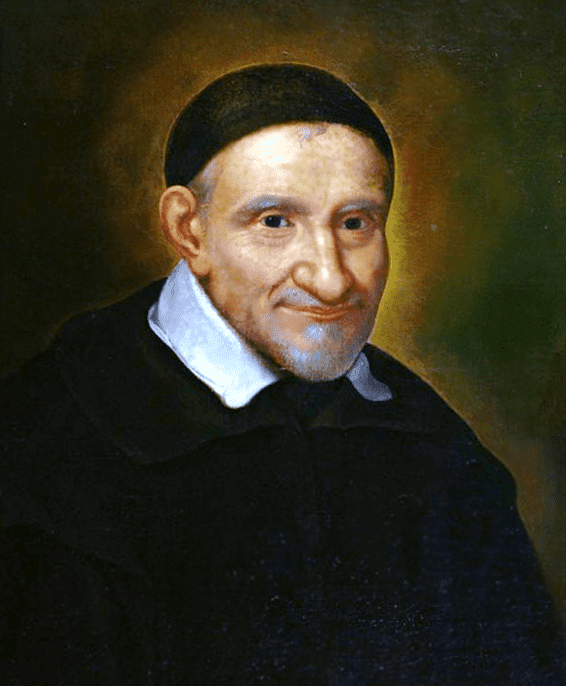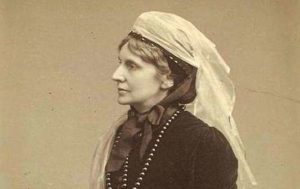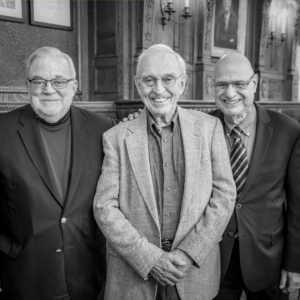(1580-1660)
Born of peasant stock in a small village in Gascony, France, Vincent de Paul never envisioned that he would devote his life to the cause of the poor. His strongest boyhood ambitions were to escape his own poverty and elevate himself socially, and it was for these practical reasons he chose the priesthood—the best career path at the time for an intelligent boy of humble background.
Young Vincent applied himself diligently to his studies with the local Franciscan friars and was able to enter the University of Toulouse in 1596 at the age of 16. At 20 he achieved ordination, and the next several years saw him well on his way to the notable ecclesiastical career he desired—serving with the papal vice-legate in Avignon, undertaking a secret papal mission to Henry IV, and becoming almoner to Queen Marguerite of Valois.
In 1612 Vincent took charge of the parish of Clichy near Paris, but he quickly left the parish to take the prestigious position of tutor to the children of the wealthy de Gondi family and spiritual director to Mme. de Gondi. Early on in this new position, however, Vincent found his heart turning away from the quest for advancement and toward the plight of the peasants on the de Gondi estate. He started a mission outreach toward the estate workers, whose physical and spiritual needs had been largely ignored by the local parish priests. His preaching to these peasants was simple and direct and focused on confession, repentance, forgiveness, and the love of God.
Leaving the de Gondi estate for a few months in 1617, Vincent returned to Paris and established the first conference of charity for the assistance of the poor. When he returned to the de Gondi estate that same year, he was accompanied by several priests who worked with him in his peasant outreach. Together they founded conferences of charity in Joigny and three other villages in Bourgogne.
One of the positions held by his patron, M. de Gondi, was that of general of the galleys of France, and Vincent’s empathy was soon captured by the abysmal conditions to which convicts were subjected before being placed aboard the galleys. Wearing leg chains, they were crowded into damp and vermin-infested dungeons, where they were given only black bread and water. Concerned with their low moral state as well as their physical deprivation, Vincent began visiting the convicts, telling them of God’s love for them and caring tenderly for their physical afflictions. Many convicts were converted, and Vincent soon enlisted other priests and lay people to visit the dungeons. This public interest led to the establishment of a hospital for convicts in Paris and another in Marseilles and to Vincent’s appointment as almoner of the galleys.
Vincent began visiting the convicts, telling them of God’s love for them and caring tenderly for their physical afflictions, leading to the establishment of a hospital for convicts in Paris and another in Marseilles.
Encouraged by the accomplishments of his missions and with the support of Mme. de Gondi, in 1625 Vincent founded a religious institute dedicated to countryside evangelism, calling it the Congregation of Priests of the Mission. Soon wealthy men and women came to him, expressing a wish to amend their lives with good works, and he organized them into a confraternity of charity dedicated to caring for the poor and visiting the sick.
At the time there was a scarcity of seminaries in France, and candidates for the priesthood often received little more than instruction in how to administer the sacraments. At the urging of the Bishop of Paris, Vincent began to conduct retreats for young men about to be ordained, although he was loath at first to dissipate the resources of his mission institute. He recognized, however, that building up the clergy would ultimately benefit the poor, and he proceeded in trust that God would provide the means, which God did, in the form of a wealthy benefactor. Vincent’s retreats, which at first lasted only 10 days, gave rise to full-fledged seminaries with courses of clerical instruction lasting for two or three years. Eventually Vincent accepted the directorship of 11 such seminaries throughout France.
The ongoing legacy of St. Vincent de Paul: In 1833, an organization called the Society of Saint Vincent de Paul was founded to carry on his work for the poor, and today it boasts more than 1 million members in 120 countries.
Out of Vincent’s charitable works arose an order of nuns called the Daughters of Charity, which today is the largest Catholic order for women worldwide. Of them he wrote, “Their convent is the sickroom, their chapel the parish church, their cloister the streets of the city.” When Vincent became aware of the huge number of infants abandoned in Paris every year, he established an orphanage and often was seen wandering through the city slums, rescuing the babies he found.
Vincent de Paul died in 1660 and was canonized in 1737.
~ Leslie Hammond


